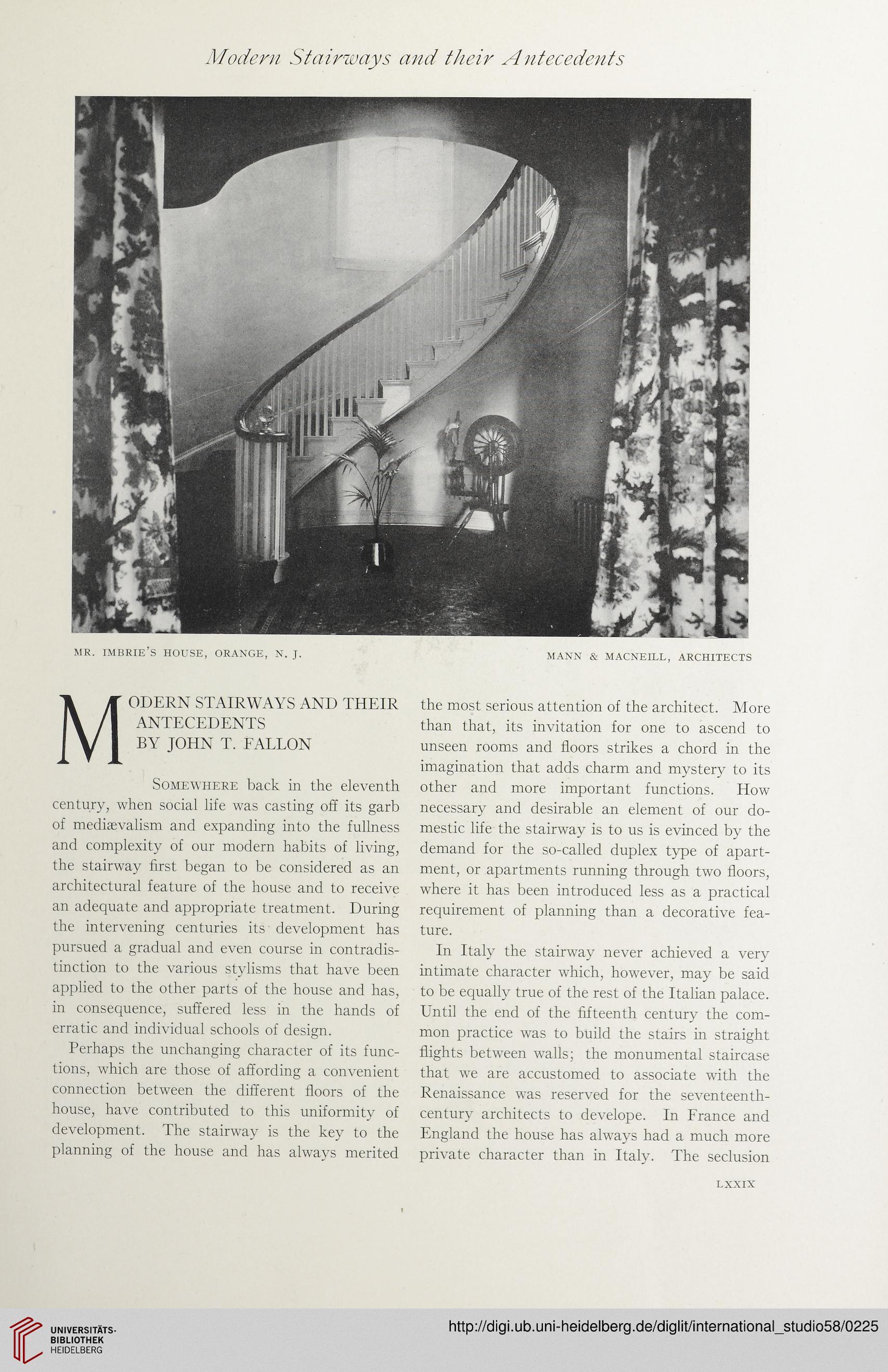Modern Stairways and their Antecedents
MR. IMBRIE’S HOUSE, ORANGE, N. J.
MANN & MACNEILL, ARCHITECTS
Modern stairways and their
ANTECEDENTS
BY JOHN T. FALLON
Somewhere back in the eleventh
century, when social life was casting off its garb
of mediaevalism and expanding into the fullness
and complexity of our modern habits of living,
the stairway first began to be considered as an
architectural feature of the house and to receive
an adequate and appropriate treatment. During
the intervening centuries its development has
pursued a gradual and even course in contradis-
tinction to the various stylisms that have been
applied to the other parts of the house and has,
in consequence, suffered less in the hands of
erratic and individual schools of design.
Perhaps the unchanging character of its func-
tions, which are those of affording a convenient
connection between the different floors of the
house, have contributed to this uniformity of
development. The stairway is the key to the
planning of the house and has always merited
the most serious attention of the architect. More
than that, its invitation for one to ascend to
unseen rooms and floors strikes a chord in the
imagination that adds charm and mystery to its
other and more important functions. How
necessary and desirable an element of our do-
mestic life the stairway is to us is evinced by the
demand for the so-called duplex type of apart-
ment, or apartments running through two floors,
where it has been introduced less as a practical
requirement of planning than a decorative fea-
ture.
In Italy the stairway never achieved a very
intimate character which, however, may be said
to be equally true of the rest of the Italian palace.
Until the end of the fifteenth century the com-
mon practice was to build the stairs in straight
flights between walls; the monumental staircase
that we are accustomed to associate with the
Renaissance was reserved for the seventeenth-
century architects to develope. In France and
England the house has always had a much more
private character than in Italy. The seclusion
LXXIX
MR. IMBRIE’S HOUSE, ORANGE, N. J.
MANN & MACNEILL, ARCHITECTS
Modern stairways and their
ANTECEDENTS
BY JOHN T. FALLON
Somewhere back in the eleventh
century, when social life was casting off its garb
of mediaevalism and expanding into the fullness
and complexity of our modern habits of living,
the stairway first began to be considered as an
architectural feature of the house and to receive
an adequate and appropriate treatment. During
the intervening centuries its development has
pursued a gradual and even course in contradis-
tinction to the various stylisms that have been
applied to the other parts of the house and has,
in consequence, suffered less in the hands of
erratic and individual schools of design.
Perhaps the unchanging character of its func-
tions, which are those of affording a convenient
connection between the different floors of the
house, have contributed to this uniformity of
development. The stairway is the key to the
planning of the house and has always merited
the most serious attention of the architect. More
than that, its invitation for one to ascend to
unseen rooms and floors strikes a chord in the
imagination that adds charm and mystery to its
other and more important functions. How
necessary and desirable an element of our do-
mestic life the stairway is to us is evinced by the
demand for the so-called duplex type of apart-
ment, or apartments running through two floors,
where it has been introduced less as a practical
requirement of planning than a decorative fea-
ture.
In Italy the stairway never achieved a very
intimate character which, however, may be said
to be equally true of the rest of the Italian palace.
Until the end of the fifteenth century the com-
mon practice was to build the stairs in straight
flights between walls; the monumental staircase
that we are accustomed to associate with the
Renaissance was reserved for the seventeenth-
century architects to develope. In France and
England the house has always had a much more
private character than in Italy. The seclusion
LXXIX





